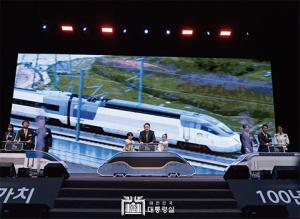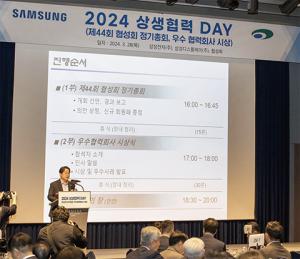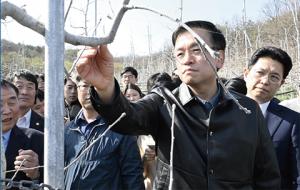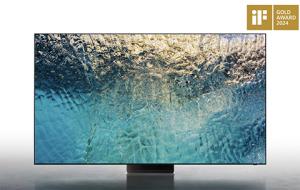 |
||
| ▲ 옥정 조철수 작가 | ||
내 표현이 자유롭게 허락하는 것과 같이 소재의 자유로움도 눈에 보이지 않는 대상이며 잘못하면 책 속으로 숨어들기도 한다. 감정의 표현은 또 하나의 행위이며 대화이기도 하며 자기 자신이 열어가는 삶이기도 하다. 혼의 예술은 내 앞에 있으며 혼을 담기 위해 새벽이 밝아오고 하루가 저물어가기도 한다. 삶의 공간 속에 이루어지고 있는 그림의 여백은 남기기는 쉬워도 그리기는 쉽지 않다. 여백은 남기는 것이 아니라 그리는 것이기 때문이다. (작가노트 중에서)
태극 문양과 아리랑 등으로 한민족의 아름다움 표현해
조철수 작가의 작품 세계는 우리 전통의 정신세계와 맞닿아 있다. 그의 대표작 중 하나인 ‘아리랑’ 연작은 화선지에 짙게 배인 태극 문양과 아리랑의 선율에 맞춰 춤을 추는 여인들의 뒷모습으로 장식되어 있다. 전통 한국화를 그리는 작가들 중에서도 산수와 정물 등에서는 전통적인 표현법이 많이 이어지고는 하지만 조 작가의 작품들처럼 특유의 역동성을 화폭 안에 담아 예술로서 승화해내는 작업은 쉽게 이뤄낼 수 없는 것이었다. 특히 그의 작품 속에서는 여인들의 뒷모습이 역동적이면서도 아름답게 그려져 있어 그가 생각하는 세계의 진면목을 짐작할 수 있게 한다.
조 작가는 그림을 그려온 지 어느덧 50년의 세월이 지난 중견 작가다. 우리 민족의 숨결이자 살아온 역사인 아리랑을 그리는 조 작가는 생명에 대한 예찬을 화폭에 담아낸다. 한민족의 민족 정체성을 간직하는 노래이자 민족 해방에 대한 염원과 확신을 담은 노래인 아리랑은 2000년 시드니 올림픽에서 남․북한 선수단이 동시 입장할 때 사용되었으며 2002년 월드컵의 응원 단체 '붉은 악마'는 응원 인파가 모인 광장에서 다 함께 아리랑을 부르며 한민족을 하나로 묶어 주었다. 그 뿐 아니라 한과 고통을 환희와 광명으로 바꾸고 영원에까지 다다를 수 있는 매개체로서 아리랑은 매우 독특한 기원을 갖고 있다고 볼 수 있다.
그림과 화제(畵題)로 함께 표현한 민족의 정서
조 작가의 작품들에는 초창기 무궁화부터 시작해 대표작으로 일컬어지는 아리랑, 짙푸른 녹음을 담은 산수화에 이르기까지 우리 것에 대한 애착이 가득 들어있다. 조 작가는 우리나라의 것을 세계에 알리기 위해 가장 직관적으로 세계 관객들에게 어필할 수 있는 것이 무엇일지에 대해 거듭 고민했다. 그 결과 중국 등으로부터 내려온 화풍을 모방하는 것에만 그치지 않고 자신만의 화법을 만들어낸 후, 우리의 것이라고 세계에 널리 자랑할 수 있는 무궁화와 아리랑 등의 소재를 정했다.
우리 전통의 아름다움을 널리 알려간 결과 조 작가는 길림사범대학 한중우수작품전, 북경미술관 한중현대회화전 등 해외 전시회에도 다수 참여하여 전통문화의 아름다움을 다시 한 번 세계에 알렸으며, 독일에서 열렸던 전시회에도 한국 대표 작가로 참여한 바 있다. 당시 전시회에는 조 작가의 뛰어난 작품을 관람하기 위해 주최측이 예상했던 인원보다 훨씬 많은 사람들이 몰려 입장 시간을 한 시간 연장해야 했을 정도로 큰 인기를 끌었으며, 전시했던 33점의 작품이 모두 판매되었던 성과를 기록했다고 한다.
조 작가는 “당시 독일 전시회에는 현지 언론인들도 많이 방문해서 질문을 쏟아냈다. 그래서 소통을 위해 통역을 해야만 했는데 내가 통역을 한 분 더 모시겠다고 자청해 독일에서 간호사로 근무하시던 분을 모셨다. 우리나라는 70년대 경제 발전기부터 독일과 많은 인연이 있는 나라이지 않나. 그 자리에 모인 많은 사람들에게 그 사실을 한 번 더 알리고 싶었다”라고 이야기했다. 당시 기자들은 “왜 뒷모습을 그리기 시작했나”, “작가가 그리는 ‘아리랑’이라는 것은 무엇인가” 등 생소하게 느껴질 수 있는 한국 문화에 대한 호기심을 보였다고 한다.
조 작가에게 있어 뒷모습이란 희로애락의 모든 감정을 담고 있는 모습이다. 사람의 앞모습을 보면 그 얼굴에서 웃음이나 울음 등 한 가지의 감정을 포착할 수 있지만 뒷모습을 비치면서 직관적인 감정을 의도적으로 차단했을 때 만들어낼 수 있는 상념을 우선하는 것이다. 또한 그가 그토록 사랑하는 ‘아리랑’은 ‘가슴 아리도록 보고 싶은 임’이라는 뜻이다. 나를 버리지 말라는 마음을 담아 애절하고도 가슴 아프게 불러내는 아리랑의 선율은 한민족 고유의 한을 담은 매개체로서 조 작가의 작품 안에서 빛나고 있다.
조 작가의 작품은 주로 우리 민족의 깊은 정서와 내면을 화폭에 담아내고 있다. 대표작인 '아리랑 I'을 보면 애국가의 1절을 그만의 글씨로 담은 화제가 오른쪽 면을 장식하고 있다. 뿐만 아니라 조 작가는 "나는 대한민국 안에 있습니다. 그러기에 내 안에 대한민국을 그려 넣어 미래의 천진난만한 아이들과 웃고 떠들고 뛰어 놀고 싶습니다"라는 말로 자신의 작품 세계를 요약했다.
"국내 미술 발전 위해서는 언론과 기업 등의 체계적 지원 있어야"
삶에 대한 애착과 기쁨의 순간 그려나갈 것
이처럼 우리의 얼과 나라 사랑의 마음을 전달하고 있는 조 작가는 현재 현대미협 이사이자 한국미술협회 부이사장으로 활동하며 국내 미술계의 현실을 재조명하는 데에도 힘쓰고 있다. 또한 지역 문화센터 등에서 한국화와 문인화 등을 가르치며, 미술 활동의 저변을 높이고 취미 생활의 경계를 확장하는 것 또한 그의 중요한 일과 중 하나다. 그에게서 가장 오랫동안 배운 수강생이 20여 년의 세월을 함께했다고 하니 그의 미술에 대한 열정을 쉽게 짐작할 수 있다.
조 작가는 "국내 미술의 발전을 위해서는 대중들이 미술에 대한 예의를 지켜줄 수 있어야 한다. 이를 위해서는 언론을 비롯해 기업 및 정부기관 등에서도 체계적인 지원을 아끼지 않아야 한다. 예전에는 미술대전이나 큰 전시회를 하면 신문 전면에 보도되고 공중파 9시 뉴스 꼭지로도 보도된 적이 있었는데 지금은 그마저도 요원한 상황이다. 우리 이웃 나라인 일본에서는 한 분야의 장인을 만나기 위해서는 한 달의 시간을 기다려야 할 만큼 사회 전반적으로 예술 등의 분야에 대한 존중 의식이 확고히 자리 잡아 있는데 우리나라는 아직 그런 부분에서 많이 부족한 것 같다. 이럴 때야말로 기업 및 기관 등에서 더욱 발 벗고 나서 국내 예술의 부흥을 위해 힘써줬으면 한다"라는 말로 소감을 대신했다.
마지막으로 조 작가는 "예술 하는 사람들은 돈을 벌기가 쉽지 않다. 요즘 사회가 더욱 각박해지는 만큼 미술을 배우려는 사람들도 직업으로 하기보다는 취미로 하려는 사람들이 훨씬 많다. 그럼에도 힘들게만 느껴지는 이 길을 꾸준히 가고자 하는 사람들은 언제나 있어 왔으며, 내가 가르친 제자가 개인전을 하거나 어느 전시회에서 수상했다는 소식 등을 들으면 그렇게 기분이 좋을 수 없다. 그런 보람이 있기에 힘들다면 힘들 수 있는 예술인의 길을 지금까지 걸어올 수 있었던 것 같다"고 말하며 작품 활동에 정진하고자 하는 뜻을 전했다. 치마 저고리를 입고 덩실덩실 춤을 추는 '아리랑' 속 여인들처럼, 조 작가의 작품 세계에도 삶에 대한 애착과 예찬, 기쁨의 순간들이 녹아 있다. 앞으로 더욱 만개할 조 작가의 작품 세계에 큰 기대를 보낸다.
[Art] Artist Okjeong Jo Chul-su
Tradition meets modern uniqueness
"The expression of one's emotion is a dialogue or an act of opening one's daily life. The art of soul is right in front of me and I endeavor to catch the soul into my work and thus close the door of another day. The blank on the canvas is not to be left for blank's sake but it happens as the result of drawing." - Artist's note -
The Korean beauty represented by the yin-yang symbol and arirang
Jo's representative work 'Arirang' shows the back of women dancing to the rhythm of arirang, the most famous Korean folk song, on a Korean paper. The work is unique in terms of its dynamism as most traditional Korean landscape paintings or still lives are static. Jo has walked a single pass as an artist for the last 50 years. He has delivered his admiration to all living things through the song arirang where the breathing of the Korean race has been residing. The song is a symbol of our identity and hope and conviction. It came out through the speaker when the national teams of North and South Koreas were entering the stadium at the Sydney 2000 Summer Olympics and many Koreans became emotional. The Korean football supporters Red Devil also sang the song on Seoul Plaza for national unity at the 2012 FIFA Club World Cup. Arirang turns our pain to joy and leads us to eternity, some say.
National sentiment expressed in poem on painting
Rose of sharon and landscape are also main themes of Jo alongside arirang. Jo has not used rose of sharon and arirang according to their traditional norms but added his color to give a uniqueness. This uniqueness, Jo thinks, is the fuel to promote the beauty of Korea to the world. In line of this effort, Jo has participated in a number of overseas exhibitions including the Jilin Normal University Korea-China Fine Arts Exhibition and the Beijing Museums Korea-China Modern Art Exhibition. He also participated in an exhibition held in Germany as the representative Korean artist and all of his 33 works were sold with one hour extended exhibition time due to the explosive number of visitors. "I invited a nurse who was working in Germany at that time as a translator during the exhibition for I was flooded in with questions of the local reporters. I wanted to remind people of the fact that many Koreans were dispatched to Germany for nursing and mining during the 70s. The reporters asked me questions like "Why do you draw the back of people?" and "What does arirang mean?" said Jo in retrospect and continued "The back of a person gives me a sense of feeling about his emotions good or bad in honest while the front expresses either forced smiley or sad faces. Arirang for me means 'the beloved one who I miss so much'. It is a song of a desperate heart to bring back one's lost love." The work 'Arirang I', for example, is added with the first verse of the national anthem on the right side.
"I will draw the joy and love of every single moment of my life"
Jo is a director of the Modern Art Association and the deputy president of the Korean Fine Arts Association. He also teaches local residents Korean painting at culture centers in an effort to promote art activities to the public and the oldest of his students have been with Jo for 20 years. "I really feel the need for the government and the media to have interest in art and to support artists and exhibitions systematically. Back then in Korea, the media treated art exhibitions as one of the main news but it seems that not many people today care about art. I only feel regretful knowing the fact that people willingly wait at least a month to meet a master artist with respect in Japan. I hope more people and companies give an effort, small or big, in promoting art and culture in Korea" said Jo and added "Not many people can afford to be an artist even though they have a great talent. They just have to feel satisfied by carrying it on as a hobby. Yet I feel really happy whenever one of my students hold a solo exhibition. This encourages me to make more effort in promoting art in Korea alongside my own creative zeal." <Power Korea> sends a message of support.
안정희 기자 honesty5835@naver.com







